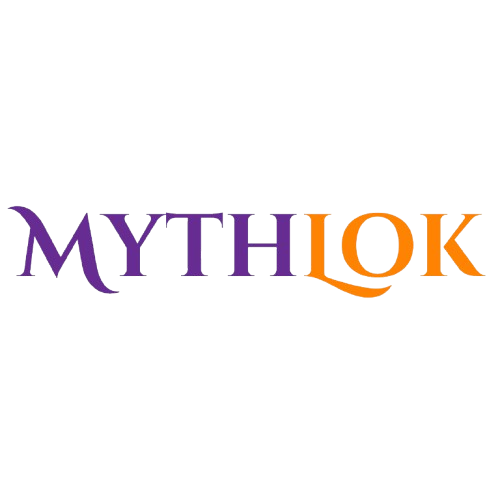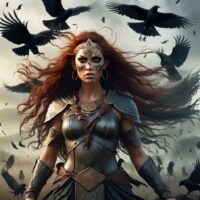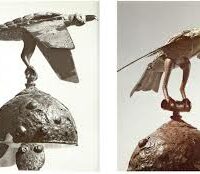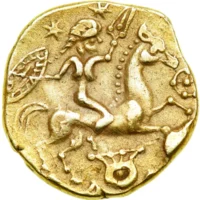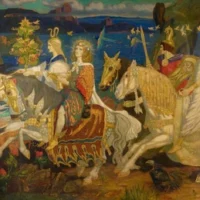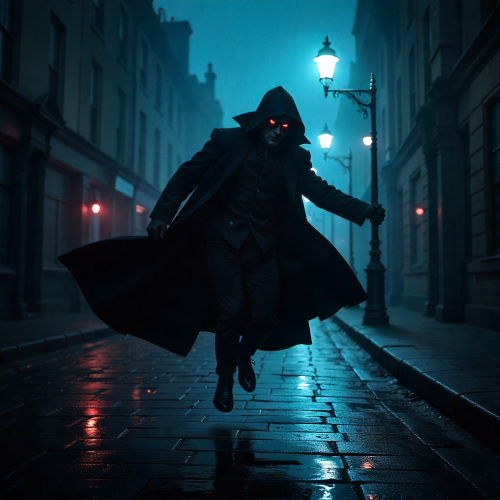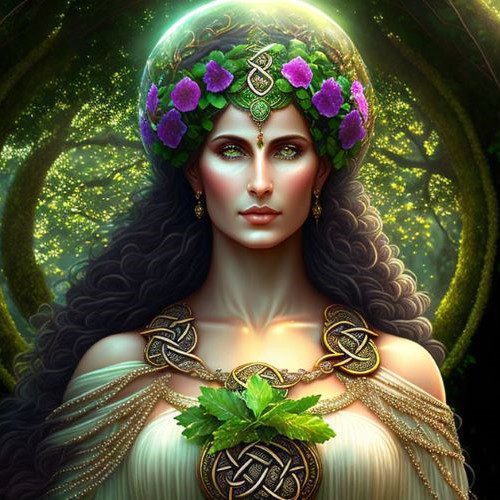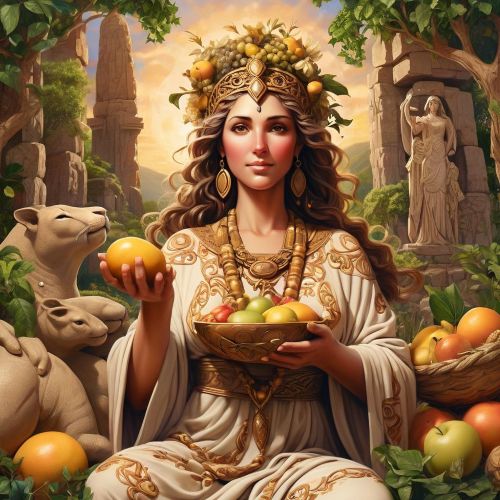Cathubodua : The Battle Goddess
Listen
At a glance
| Description | |
|---|---|
| Origin | Gaulish Mythology |
| Classification | Gods |
| Family Members | N/A |
| Region | France, Switzerland |
| Associated With | Crows, Warfare |
Cathubodua
Introduction
In the rich and complex world of ancient Celtic mythology, few figures are as shrouded in mystery—and yet as symbolically powerful—as Cathubodua. Originating from the Gaulish pantheon, she stands as a fierce and enigmatic goddess of war. While not as widely recognized today as deities like Morrigan or Brigid, Cathubodua carries with her the raw energy of the battlefield and the ominous cry of the crow that circles above it.
Her name, which scholars interpret as meaning “battle crow,” already hints at her nature. Birds like crows and ravens often appear in Celtic myths as harbingers of fate, messengers of the gods, or even gods themselves in disguise. Cathubodua fits perfectly into this symbolic tradition, representing both the chaos of war and the spiritual forces that guide it.
Physical Traits
Descriptions of Cathubodua are scarce, yet those that survive—or that can be inferred—paint her as a figure of intense presence. One can imagine her as a goddess cloaked in dark feathers or clad in armor, a spear or sword in hand, eyes sharp and foreboding. The imagery of the crow is central to her identity, not merely as a decorative symbol but as an extension of her divine essence. Crows were thought to feast on the fallen after battle, but in Cathubodua’s case, they also represent foresight, protection, and sometimes divine judgment. Though she shares traits with other war goddesses from Celtic traditions, Cathubodua’s connection to the battlefield feels more visceral and immediate. She’s not just a figure of myth; she is the storm that breaks over an army, the shadow that passes before a warrior falls.
Family
Unlike more fully developed mythological figures, Cathubodua doesn’t appear in detailed sagas or familial trees. However, scholars and enthusiasts often link her to deities like Badb and the Morrigan from Irish mythology—goddesses who also wield the power of war, prophecy, and transformation. In fact, some argue that Cathubodua could be a local variation of these better-known figures, adapted to suit the particular beliefs of the Gaulish tribes.
The shared themes between these goddesses are striking. Badb, for example, is also associated with the crow and is known for foretelling doom in battle. Morrigan, often depicted as a shapeshifter, plays a role in influencing the outcome of wars and guiding the souls of fallen heroes. Cathubodua may not have a detailed mythology of her own, but through these parallels, we begin to understand her place in the spiritual landscape of the Celts.
Other names
The historical record of Cathubodua is slim, but not entirely absent. Her name appears in a Latin inscription found in Mieussy, France—evidence that she was worshipped, or at least acknowledged, in the Roman-occupied regions of Gaul. Interestingly, the inscription refers to her in a way that blends native and Roman elements, which suggests that her worship may have evolved over time or been syncretized with Roman beliefs.
Alternate spellings and similar names like Catubodua and Cassibodua have appeared in studies of ancient Celtic languages. Whether these are distinct figures or regional variations of the same deity is still up for debate, but they reinforce the notion that the battle crow archetype had wide-reaching influence.
Powers and Abilities
While Cathubodua’s lore isn’t filled with grand epics, her role as a war deity speaks volumes. She embodies the unpredictable, brutal, and transformative nature of battle. It’s likely that Gaulish warriors looked to her not just for protection but for guidance, strength, and the favor of victory. In the heat of combat, invoking Cathubodua might have been a way to harness one’s courage—or to intimidate an enemy with the silent promise of divine wrath.
There’s a legend, likely apocryphal but deeply evocative, of a crow aiding a Roman soldier during a duel by attacking his Gaulish opponent. To onlookers, this was no ordinary bird—it was a sign from the gods. While no written source directly links this tale to Cathubodua, it echoes her symbolic role and the ancient belief that deities intervened in human affairs in subtle but decisive ways. Prophecy, too, was part of her domain. Just as the appearance of a crow might foreshadow death or triumph, Cathubodua’s presence suggested a deeper truth hidden within the fog of war. She was not just a bringer of death, but a seeress of destiny.
Modern Day Influence
In today’s world, Cathubodua is far from forgotten. Among modern pagans, particularly those who follow Celtic reconstructionist paths, she is honored as a powerful goddess of protection, strength, and strategic insight. She appeals to those who seek to channel inner courage, confront challenges head-on, or explore the darker, more primal aspects of spirituality.
Groups like the Coru Cathubodua Priesthood are dedicated to reviving her legacy. Through ritual, scholarship, and storytelling, they are piecing together the fragments of her history and bringing her into the present as a symbol of resilience and warrior spirit. Her image—part crow, part warrior—also appears in literature, art, and even some fantasy role-playing games. She inspires characters and stories that explore the fine line between fate and free will, and the cost of power in times of conflict. In this way, she lives on not just in altars and offerings, but in imagination and creative expression.
Related Images
Source
Pictet, Adolphe (1868): SUR UNE NOUVELLE DÉESSE GAULOISE DE LA GUERRE. Revue Archéologique.
“The Ancient Celtic Pantheon – World History Encyclopedia,” 2021.
“Cathubodua – Myth and Folklore Wiki,” mythus.fandom.com
“Cathubodua Goddess: Unveiling the Celtic War Deity’s Power and Influence,” OldWorldGods.com, 2023.
Beck, Noémie, “Goddesses in Celtic Religion: Territorial and War Goddesses,” 2009.
Wikipedia: Cathubodua
Frequently Asked Questions
What is lorem Ipsum?
I am text block. Click edit button to change this text. Lorem ipsum dolor sit amet, consectetur adipiscing elit. Ut elit tellus, luctus nec ullamcorper mattis, pulvinar dapibus leo.
What is lorem Ipsum?
I am text block. Click edit button to change this text. Lorem ipsum dolor sit amet, consectetur adipiscing elit. Ut elit tellus, luctus nec ullamcorper mattis, pulvinar dapibus leo.
What is lorem Ipsum?
I am text block. Click edit button to change this text. Lorem ipsum dolor sit amet, consectetur adipiscing elit. Ut elit tellus, luctus nec ullamcorper mattis, pulvinar dapibus leo.
What is lorem Ipsum?
I am text block. Click edit button to change this text. Lorem ipsum dolor sit amet, consectetur adipiscing elit. Ut elit tellus, luctus nec ullamcorper mattis, pulvinar dapibus leo.
What is lorem Ipsum?
I am text block. Click edit button to change this text. Lorem ipsum dolor sit amet, consectetur adipiscing elit. Ut elit tellus, luctus nec ullamcorper mattis, pulvinar dapibus leo.

